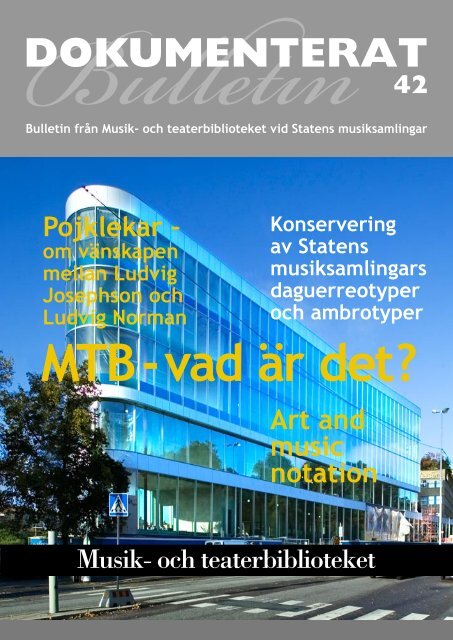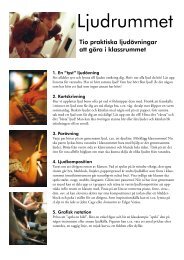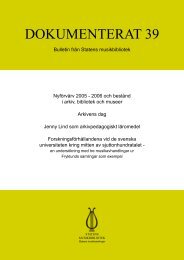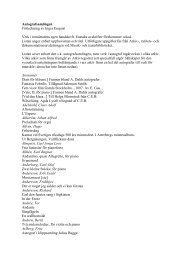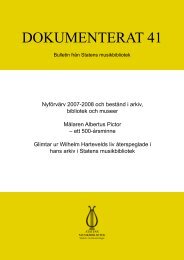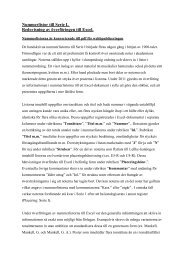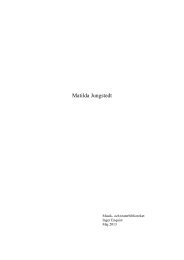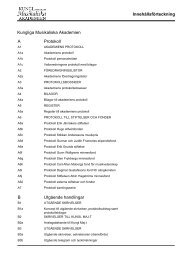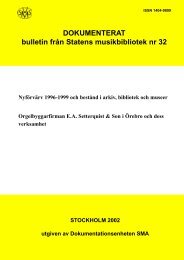Ladda ner (PDF) - Statens musikverk
Ladda ner (PDF) - Statens musikverk
Ladda ner (PDF) - Statens musikverk
Create successful ePaper yourself
Turn your PDF publications into a flip-book with our unique Google optimized e-Paper software.
Bulletin<br />
dokumenterat<br />
42<br />
Bulletin från Musik- och teaterbiblioteket vid <strong>Statens</strong> musiksamlingar<br />
Pojklekar –<br />
om vänskapen<br />
mellan Ludvig<br />
Josephson och<br />
Ludvig Norman<br />
MTB - vad är det ?<br />
1<br />
Konservering<br />
av <strong>Statens</strong><br />
musiksamlingars<br />
daguerreotyper<br />
och ambrotyper<br />
Art and<br />
music<br />
notation<br />
Musik- och teaterbiblioteket
Utges av Arkiv-, raritets- och dokumentationsavdelningen<br />
på Musik- och teaterbiblioteket vid <strong>Statens</strong> musiksamlingar<br />
Postadress: Box 16326, 103 26 Stockholm<br />
Besöksadress: Torsgatan 19, Stockholm<br />
Telefon: 519 554 18 Överbibliotekarie<br />
519 554 17 Arkiv<br />
519 554 30 Bibliografi<br />
519 554 97 Bilder<br />
519 554 33 Rariteter<br />
519 554 47 Teater<br />
Fax: 519 554 05<br />
E-post: inger.enquist@muslib.se, kia.hedell@muslib.se<br />
ISSN 1404-9899<br />
Dokumenterat 42, red. Inger Enquist och Kia Hedell,<br />
november 2010<br />
Omslagsfoto: Thomas Wingstedt<br />
Grafisk form: Tuula Rinne<br />
2
Innehåll<br />
MTB – vad är det? s.4<br />
Veslemöy Heintz<br />
Konservering av <strong>Statens</strong> musiksamlingars<br />
daguerreotyper och ambrotyper s.7<br />
Agnes Sjöbrandt<br />
Pojklekar – om vänskapen mellan<br />
Ludvig Josephson och Ludvig Norman s.15<br />
Marianne Seid<br />
Art and music notation s.24<br />
Inger Enquist<br />
3
MTB – vad är det?<br />
Av Veslemöy Heintz 1<br />
Bakgrund<br />
1/1 2010. Äktenskap<br />
har ingåtts mellan<br />
<strong>Statens</strong> musikbibliotek<br />
och Biblioteket vid<br />
Sveriges teatermuseum.<br />
Parterna har beslutat<br />
att anta följande<br />
namn: Musik- och<br />
teaterbiblioteket vid<br />
<strong>Statens</strong> musiksamlingar. 2<br />
I oktober 2005 beslöt regeringen att en särskild utredare skulle göra<br />
en översyn av scenkonstens dokumentation. I syfte att öka samlingarnas<br />
tillgänglighet och vårdinsatsernas kvalitet skulle utredaren även<br />
undersöka möjligheter till samordning mellan Dansmuseet och Sveriges<br />
teatermuseum. 3 Till utredningsman utsågs överintendenten Keith<br />
Wijkander.<br />
Utredningen, Klenoder i tiden, överlämnades till Utbildnings- och<br />
kulturdepartementet i juli 2006. Utredningsmannen förordade att<br />
Sveriges teatermuseum och Dansmuseet skulle inordnas i <strong>Statens</strong><br />
musiksamlingar. Den nya myndigheten borde därmed få ett utvidgat<br />
uppdrag som utöver musiken även omfattade dokumentation av scenkonstens<br />
aktuella utveckling samt retrospektiv insamling om dess historia.<br />
3 Wijkander framhöll att Sveriges teatermuseum och Dansmuseet<br />
var så små organisatio<strong>ner</strong> att en samverkan dem emellan inte<br />
skulle leda till den kompetensbredd som, enligt honom, krävdes för<br />
att kunna verka på en nationell ansvarsnivå.<br />
1 Veslemöy Heintz är överbibliotekarie på Musik-och teaterbiblioteket vid<br />
<strong>Statens</strong> musiksamlingar.<br />
2 Två marionetter ur ”Collezione G. Oreglia” (Musik- och teatermuseet).<br />
Foto: Sveriges teatermuseum.<br />
3 Läs mera om hela förslaget i Klenoder i tiden, SOU 2006:68, s. 18-23.<br />
4
Expeditionen i Gäddviken. Foto: Sveriges teatermuseum.<br />
Efter remissomgången stod det klart att Dansmuseet motsatte sig en<br />
sammanslagning, medan Sveriges teatermuseum ställde sig positivt.<br />
Regeringen beslöt i enlighet med remissvaren, och från den 1 januari<br />
2010 upphörde Sveriges teatermuseum 4 att existera, i stället uppstod<br />
två nya enheter inom <strong>Statens</strong> musiksamlingar: Musik- och teatermuseet<br />
och Musik- och teaterbiblioteket.<br />
Det nya Musik- och teaterbiblioteket<br />
Vad innebär nu denna nyordning för <strong>Statens</strong> musikbiblioteks avnämare?<br />
Rent praktiskt egentligen ingenting: Låneexpeditionen ligger kvar<br />
på Torsgatan 19, och det är ingen ändring av öppettider eller fjärrlåneverksamhet.<br />
Dock har de av bibliotekets arkiv och samlingar som<br />
fanns på Sibyllegatan 2 överflyttats till Teatermuseets gamla lokaler<br />
i Gäddviken Nacka. 5 Detta innebär på många sätt en förbättring: Ett<br />
utökat öppethållande och en utmärkt läsesal med möjligheter till kopiering<br />
(vi återkommer så småningom på vår hemsida med uppgifter<br />
om öppettider med mera).<br />
4 Huvudman för Sveriges teatermuseum var Stiftelsen Drottningholms teatermuseum.<br />
I Stiftelsens verksamhet ingick även föreställningsverksamheten vid<br />
Drottningholmsteatern. Den gamla stiftelsen upplöstes genom s.k. permutation,<br />
Sveriges teatermuseum med sina biblioteks-, arkiv- och föremålssamlingar<br />
kunde därmed inordnas i <strong>Statens</strong> musiksamlingar och en ny stiftelse<br />
ansvara för föreställningsverksamheten.<br />
5 Adressen är Kvarnholmsvägen 56, ingång 3, man tar buss 402 från Slussen.<br />
5
För Teaterbibliotekets låntagare har nyordningen både för och nackdelar:<br />
referenssamlingen, böcker, pjäser och tidskrifter har flyttats till<br />
lokalerna på Torsgatan, något mera centralt beläget än den nuvarande<br />
lokalen i Gäddviken och med bättre öppettider. Men flytten innebär att<br />
Teaterbibliotekets bestånd splittras; arkivmaterialet kommer att ligga<br />
kvar i lokalerna i Gäddviken.<br />
Den stora vinsten för både musik- och teaterbibliotekets kunder är<br />
naturligtvis den fantastiska samling som uppstår genom denna sammanslagning.<br />
Läsare av denna tidskrift vet förhoppningsvis redan att<br />
musikbiblioteket är ett av de största i sitt slag i Europa och det enda<br />
offentliga specialbiblioteket på musikområdet i Sverige. Vi har rika<br />
forskningssamlingar (vår s.k. raritetssamling och många musikarkiv),<br />
dessutom noter i alla genrer och musiklitteratur för utlån.<br />
Teaterbiblioteket är ett av norra Europas största specialbibliotek för<br />
de sceniska konstarterna. Samlingen innehåller drygt 73 000 volymer<br />
från 1499 och framåt. Här finns teatervetenskaplig litteratur, biografier<br />
och pjäsmanuskript samt böcker i ämnen som teaterteori, dramaturgi,<br />
regi, skådespelar- och sångkonst, dans, mim, musikteater, kostym,<br />
mask och smink samt scenografi och scenljus. Sedan 1996 finns Teatermuseets<br />
litteratur katalogiserad i Libris. Den gamla kortkatalogen<br />
över bestånden från före 1996 har digitaliserats och lagts ut på vår<br />
webbplats.<br />
Teaterbiblioteket har också ett stort arkiv med samlingar som speglar<br />
svensk teaterhistoria från sent 1700-tal fram till våra dagar. Här finns<br />
material om olika former av scenkonst som drama, opera, operett,<br />
dans, revy, varieté, mim och mycket annat. Arkivet innehåller ett stort<br />
antal enskilda arkiv, ett omfattande pressklippsarkiv samt samlingar<br />
av pjäsmanuskript, affischer och program. Ett register över samlingens<br />
olika arkiv finns tillgängligt på Teatermuseets webbplats. 6<br />
Det kommer naturligtvis att ta sin tid för detta nya äktenskap att hitta<br />
sin form, men vi ser framtiden an med tillförsikt. Under hösten har<br />
samlingarna flyttats fysiskt — teaterlitteraturen från Gäddviken till<br />
Torsgatan och musikarkiven från Sibyllegatan till Gäddviken. Därefter<br />
följer internutbildning för att vi skall lära känna våra respektive samlingar<br />
och så småningom kommer en ny, gemensam webbplats.<br />
Vi önskar våra kunder, nya som gamla, hjärtligt välkomna till Musik-<br />
och teaterbiblioteket.<br />
6 Arkivregister teatersamlingarna finns på<br />
http://teatermuseet.se/sv/arkiv/arkivregister<br />
Register över musikarkiven finns på<br />
http://www.muslib.se/arkivregister_dec08.html<br />
6
Konservering av <strong>Statens</strong><br />
musiksamlingars daguerreo-<br />
typer och ambrotyper<br />
Av Agnes Sjöbrandt 1<br />
Bakgrund<br />
Vid en inventering 2009 av dåvarande Musikmuseets daguerreotyper<br />
och ambrotyper upptäcktes att flera var i mycket dåligt skick. Om de<br />
inte konserverades skulle de sannolikt förstöras.<br />
Genom Nordiska museets Fotosekretariat fick vi kontakt med Lennart<br />
Andersson, foto- och papperskonservator vid Västarvet/Kulturlagret<br />
i Vä<strong>ner</strong>sborg. Lennart påtog sig uppdraget att konservera de skadade<br />
daguerreotyperna och ambrotyperna och påbörjade arbetet under<br />
oktober 2009.<br />
Daguerreotypi är en fotografisk process som användes<br />
1839 – ca 1860. En daguerreotyp är en kopparskiva med<br />
ett silverskikt på vilket bilden finns. Bilden är uppbyggd<br />
av mikroskopiskt små kvicksilverdroppar som fixeras på<br />
kopparskivan genom att den utsätts för giftiga kvicksilverångor.<br />
Varje daguerreotyp finns bara i ett exemplar<br />
och bilden är positiv och spegelvänd. Daguerreotyper är<br />
mycket ömtåliga och monteras under en lufttät glasskiva.<br />
Ambrotypi är en fotografisk process som användes 1851-<br />
ca 1880. En ambrotyp består av ett kollodiumskikt på en<br />
glasplåt med en tunn negativ silverbild som ser positiv<br />
ut mot en svart bakgrund. Den färdiga bilden är ömtålig<br />
och skyddas ofta med glas och ram. Ambrotyper är ibland<br />
handkolorerade.<br />
1 Agnes Sjöbrandt är arkivarie på Musik- och teaterbiblioteket vid <strong>Statens</strong><br />
musiksamlingar.<br />
7
Lennart Andersson packar upp de konserverade fotografierna. Inger Enquist<br />
(sittande från vänster), Agnes Sjöbrandt och Veslemöy Heintz väntar på att<br />
få se resultatet. Fotograf: Lars Lindgren.<br />
Daguerreotyper och ambrotyper i våra<br />
samlingar<br />
I våra samlingar finns 16 daguerreotyper och 8 ambrotyper. De har<br />
inkommit till museet som gåvor, några tillsammans med personarkiv.<br />
Alla motiven är porträtt, 18 st identifierade och 6 st oidentifierade.<br />
De identifierade perso<strong>ner</strong>na har alla kopplingar till musiklivet, anting–<br />
en som utövande musiker/sångare eller tonsättare.<br />
Vi bedömde att nio av daguerreotyperna och tre av ambrotyperna var<br />
i behov av konservering. Skadorna var av olika karaktär. För daguerreotyperna<br />
handlade det om skadade skyddsglas som behövde bytas<br />
ut.Tre av de nio daguerreotyperna har under 1980-talet genomgått<br />
konservering vid Nationalmuseum i Danmark. Efter konserveringen har<br />
de inte monterats tillbaka i sin ram med skyddsglas utan legat oskyddade<br />
i över 20 år. Originalramarna fanns kvar och var möjliga att återanvända.<br />
Ambrotyperna som behövde konserveras hade söndervittrad/<br />
uttorkad bakgrundsfärg som skulle bytas ut.<br />
8
Lennart Andersson berättar om konserveringsarbetet. Foto: Lars Lindgren.<br />
Nedan följer en sammanställning av våra daguerreotyper och ambrotyper<br />
som visar motiv, fotograf och vilka som behövde åtgärdas.<br />
Motiv Fotograf Behov av<br />
konservering<br />
Daguerreotyper<br />
Jenny Lind Kilburn Nej<br />
Jenny Lind Johan Wilhelm Bergström Nej<br />
Jenny Lind Johan Wilhelm Bergström Nej<br />
Wendela Hebbe Johan Wilhelm Bergström Ja<br />
Kapten Stiebel Johan Wilhelm Bergström Nej<br />
Signe Hebbe Ad. Anjoux Ja<br />
Signe Hebbe Désiré Francois Millet Ja<br />
Fredrika Arnoldson Okänd Nej<br />
Clemens Hebbe J H Whitehurst Nej<br />
Adolf Fredrik Lindblad +<br />
två kvinnor Okänd Ja<br />
Adolf Fredrik Lindblad Okänd Ja<br />
Oidentifierad man Johan Wilhelm Bergström Ja<br />
Charlotta Lindmark Okänd Ja<br />
Caroline Ungher<br />
Sabatier Okänd Nej<br />
Oidentifierad kvinna Désiré Francois Millet Ja<br />
Oidentifierad man Lorenzo Suscipj Ja<br />
Ambrotyper<br />
Elise Hwasser Okänd Ja<br />
Josef Dente Okänd Nej<br />
Josef Dente W.A. von Boeckmann Nej<br />
Christina Nilsson Okänd Nej<br />
Oidentifierad man Okänd Nej<br />
Oidentifierad kvinna Okänd Ja<br />
Anonym ung man m. violin John Rosendahl, Carlstad Nej<br />
Christina Elisabeth Frösslind J F Dahlbom Ja<br />
9
Resultatet<br />
I början av februari 2010 var arbetet klart och Lennart Andersson<br />
presenterade resultatet för oss. Lennart visade upp de konserverade<br />
daguerreotyperna och ambrotyperna och berättade hur han hade konserverat<br />
varje bild. Han gav oss också goda råd för framtida förvaring<br />
och hantering av gamla och ömtåliga fotografier. Lennart berättade<br />
att när han plockade isär de gamla ramarna upptäckte han några<br />
stämplar och etiketter med uppgifter om fotografer som låg dolda<br />
under flera lager papper. För oss var detta värdefull information.<br />
Arbetet hade dessutom varit lärorikt för Lennart som fick tillfälle att<br />
montera isär många daguerreotyper samtidigt och kunde då jämföra<br />
hur de var monterade.<br />
Lennart dokumenterade sitt arbete, både i en skriftlig rapport och<br />
genom att fotografera varje steg i konserveringsarbetet. Till sist visas<br />
delar av dokumentationen nedan:<br />
10<br />
K801 före montering.<br />
Fotograf: Lennart Andersson.
K801<br />
Daguerreotyp föreställande Signe Hebbe (1837-1925), Paris 1858.<br />
Fotograf: Désiré Francois Millet. Fotografiet har förvarats utan<br />
skyddsglas och ram sedan 1980-talet och monterades nu in i sin<br />
originalram.<br />
K801 monterad i sin originalram. Fotograf: Lennart Andersson.<br />
11
Ovan: K846 före<br />
konservering.<br />
Fotograf: Lars Lindgren.<br />
Till höger: K846,<br />
skannad. Fotograf:<br />
Lennart Andersson.<br />
12<br />
K846<br />
Ambrotyp föreställande<br />
Christina Elisabeth<br />
Frösslind (1793-1861).<br />
Fotograf: J. F. Dahlbom.<br />
Asfaltlacken på baksidan<br />
hade krackelerat.<br />
Ny färg målades på.<br />
När fotografiets ram var<br />
bortmonterad skannades<br />
bilden. Det fantastiska<br />
resultatet visas nedan.
K1872<br />
Daguerreotyp föreställande oidentifierad man. Fotograf: Johan Wilhelm Bergström. Det ena hörnet av<br />
skyddsglaset saknades och de delar av fotografiet som har expo<strong>ner</strong>ats för luft hade förstörts. Ram och<br />
skyddsglas byttes ut.<br />
K1872 före konservering. Fotograf: Lars Lindgren. K1872 med nytt skyddsglas och ram. Fotograf:<br />
Lennart Andersson.<br />
K1908<br />
Daguerreotyp föreställande oidentifierad man. Fotograf: Lorenzo Suscipj. Daguerreotypens skyddsglas<br />
var spräckt och byttes ut.<br />
K1908 före konservering. Fotograf: Lars Lindgren.<br />
13<br />
K1908 under konserveringsarbetet. Fotograf:<br />
Lennart Andersson.
K1908 Övre högra hörnet märkt ”GARANTIE”. Fotograf: Lennart Andersson.<br />
K1908 med nytt skyddsglas. Här syns tydliga märken där luft har kommit in<br />
genom det gamla spräckta skyddsglaset. Fotograf: Lennart Andersson.<br />
14
Pojklekar – om vänskapen<br />
mellan Ludvig Josephson<br />
och Ludvig Norman<br />
Av Marianne Seid 1<br />
Pojklekar – så beskriver Ludvig Josephson själv de ”privatsceniska”<br />
och ”privatpublicistiska” aktiviteter som han och vännen Ludvig<br />
Norman ägnade sig åt åren 1842-1847. 2 Spåren av dessa lekar återfinns<br />
i det arkiv efter Ludvig Josephson som finns i Musik- och teaterbibliotekets<br />
samlingar. 3 Här finns en rad både roande och rörande<br />
dokument som ger en bild av hur de båda pojkarna lekte pjäsförfattare,<br />
skådespelare, teaterdirektörer och tidningsredaktörer. 4 Pojk–<br />
lekarna tycks ha lämnat bestående intryck hos de båda – i ett brev till<br />
Josephson från 1884 skriver Norman: …”minns Du ännu den sorgfria<br />
tiden, då vi spelade Theater tillsammans, och skrefvo pjeser, den<br />
ena gudomligare än den andra, och huru vi om aftnarne för hela den<br />
talrika Josephsonska familjen läste högt ur vår Tidning för Theater<br />
och Musik…”. 5<br />
Ludvig Oscar Josephson, skådespelare, regissör, teaterdirektör och<br />
författare, föddes i Stockholm den 20 februari 1832. Han växte upp<br />
under knappa förhållanden och redan vid fjorton års ålder fick han<br />
bidra till familjens försörjning, först som sockerbagarlärling och<br />
senare som bokhandelsbiträde. 6 Familjen Josephson tycks ha varit<br />
en begåvad familj – alla syskonen spelade något instrument och man<br />
hade ofta musikstunder som samlade många framstående perso<strong>ner</strong> ur<br />
musikvärlden. 7 Den unge Ludvig var dock mest intresserad av teatern<br />
– ett intresse som han delade med sin barndomsvän Ludvig Norman.<br />
1 Marianne Seid är arkivarie på Musik- och teaterbiblioteket vid <strong>Statens</strong><br />
musiksamlingar.<br />
2 Herman Glimstedt, 1931: ”Ludvig Normans brev till Ludvig Josephson”,<br />
Svensk tidskrift för musikforskning årg 13; s. 138.<br />
3 Arkivet är fritt tillgängligt för forskning. Det omfattar 11 volymer och<br />
står uppställt i teatersamlingarna i Gäddviken.<br />
4 Ludvig Josephsons arkiv, vol 1. Arkivförteckningen föreligger som<br />
elektronisk resurs: http://www.teatermuseet.se/filer/arkivet/<br />
Ludvig Josephsons arkiv.pdf.<br />
5 Glimstedt, 1931 s. 154.<br />
6 Stig Torsslow, 1948: ”Ludvig Josephson”, Svenska män och kvinnor,<br />
band 4, s. 118.<br />
7 Glimstedt, 1931 s. 134.<br />
15
Ludvig Josephson. Foto: Sveriges teatermuseums samlingar. Repro: Marianne<br />
Seid, Musik- och teaterbiblioteket.<br />
Fredrik Wilhelm Ludvig Norman, tonsättare, föddes även han i<br />
Stockholm, den 28 augusti 1831. 8 De båda var i det närmaste jämn–<br />
åriga, bodde under en tid i samma hus på Skomakaregatan och det var<br />
Josephsons syster Wilhelmina som gav Norman hans första ordnade<br />
undervisning i pianospel. 9 Så här beskriver Josephson pojkarnas<br />
första möte: ”Då jag gjorde hans första bekantskap, satt han bedröfvad<br />
på destillator Lundbergs vattenkärra på gården; han grät<br />
öfver att ej få bevista en föreställning af den nya opera, ’Robert af<br />
Normandiet’ 10 , som lät så mycket tala om sig. Jag deltog i hans sorg,<br />
och vi blefvo vän<strong>ner</strong>”. 11<br />
8 Mac Wassberg, 1948: ”Ludvig Norman”, Svenska män och kvinnor,<br />
band 5, s. 547.<br />
9 Glimstedt, 1931 s. 134<br />
10 Meyerbeers opera Robert av Normandie (Robert le Diable) spelades<br />
första gången i Stockholm 1839.<br />
11 Glimstedt, 1931 s. 134.<br />
16
Ludvig Norman. Foto: Sveriges teatermuseums samlingar. Repro: Marianne<br />
Seid, Musik- och teaterbiblioteket.<br />
Pjäsförfattana, skådespelarna och teaterdirektörerna<br />
Josephson & Norman<br />
I Josephsons arkiv finns ett antal pjäsmanuskript och manuskriptfragment.<br />
En del av dessa är författade av pojkarna själva medan<br />
andra är avskrifter av existerande verk. Pojkarna har i vissa fall<br />
återanvänt såväl egna som andras antecknings- och skrivböcker.<br />
I en anteckningsbok som tillhört Josephsons bror Jacob Axel finns<br />
komedin Att fira utan permission (med överstruken titel: Att älska<br />
med permission) sig<strong>ner</strong>ad Ludvig Josephson, det lyriska skådespelet<br />
Gustaf Den II Adolph samt pjäsen Skåningarne. I arkivet<br />
finns även manuskript till pjäser som Mina pengar och icke<br />
dina, Stockholms Blodbad, Fjesken och Contoristen och hans far.<br />
17
12 Glimstedt, 1931 s.132.<br />
18<br />
Jacob Josephsons anteckningsbok<br />
”Anteckningar<br />
ur Bibliska Historien och<br />
Geografien”, återanvänd<br />
av Ludvig. Foto: Marianne<br />
Seid, Musik- och teaterbiblioteket.<br />
Nedan: Contoristen och<br />
hans far, rollista. Foto:<br />
Marianne Seid.<br />
Som framgår av rollistan ovan så framträdde pojkarna själva på<br />
scenen, i såväl sina egna som andras pjäser. I Anteckningar efter<br />
brev från mig sjelf skriver Josephson: ”1844. …Vi ha haft en teater<br />
på Djurgården, där vi ha spelat hela sommaren. Ludvig Norman<br />
var teaterdirektör och tillika aktör. Jag har spelat Esmeraldas roll …<br />
och sjungit efter Ludv. Normans komposition …”. 12 Pjäsen som framfördes<br />
var tydligen Ringaren i Nôtre-Dame.
Illustration ur pojkarnas TheaterTidning No 5, 1844. Foto: Marianne Seid,<br />
Musik- och teaterbiblioteket.<br />
De unga teaterdirektörerna<br />
Josephson och Norman drev<br />
inte mindre än fyra teatrar:<br />
1sta Stora Theatern, 2dra<br />
Stora Theatern, 1sta Lilla<br />
Theatern och 2dra Lilla<br />
Theatern. Som alla goda<br />
teaterdirektörer förde de<br />
bok över vilka pjäser som<br />
uppförts vid dessa teatrar.<br />
Här kan man läsa att på<br />
2dra Stora Theatern gavs<br />
lördagen den 24 februari<br />
”För första gången Hoppet,<br />
Comedie i 5 Akter, derefter<br />
Pjäsförteckning. Foto: Marianne Seid.<br />
gafs för fjerde gången Sundvall,<br />
Comedie i 2 Akter derefter<br />
gafs de flesta sce<strong>ner</strong>na ur Natt och Morgon sen en Spansk, och<br />
Fransk Ballett och några enskilda sånger ur En Höstdag i Mora”.<br />
19
Teaterdirektörerna upprättade även regler för verksamheten.<br />
I ”Theater Förordningar för 1sta Stora Theatern” behandlas i stort<br />
sett varje aspekt av arbetet vid teatern.<br />
§1. En aktör får icke försumma en repitition eller representation<br />
utan något giltigt skäl, såsom sjukdom<br />
§2. Cigarr får icke rökas i theaterns förstugor<br />
§3. En aktör eller aktris får icke vara uppstudsig mot<br />
theaterdirektörerna<br />
§4. Hvarje af theaterns Sujett skall alltid spela den rolen dem<br />
anbefallt är<br />
§5. Hvad lönen beträffar, icke yrka derpå, utan wänta så länge<br />
som möjligt är<br />
§6. Behöfver någon Sujett af nöd sin lön så skall han sig i<br />
Cansliet anmäla<br />
§7. Att hvarje aktör före och efter representationen och<br />
repitition icke skall taga sig en klunk för mycket, och<br />
Sålunda icke kunna spela den aftonen<br />
§8. Att hvarje aktör skall bestå sig kostymer<br />
§9. Att ingen får sedan han köpt billjett i luckan afytra den till<br />
förhöjdt pris åt någon lättrogen och blifver Polisen, att noga det<br />
eftersyna befalld<br />
§10. Att hvarje, som är i Orchestern skall minst tio minuter före<br />
Spektaklets början sig infinna<br />
§11. Den aktör eller aktris, som under representationen anfalles<br />
af en häftig sjukdom skall genast såsom theaterns pligt är,<br />
hemföras och Representationen blir inställd<br />
§12. Att ordning iakttages och ingen Trängsel och slagsmål<br />
blifver om billjetterna<br />
§13. Att maschinister och vaktmästare icke skola släppa in<br />
någon, som icke har billjet, och får den vaktmästare, som bryter<br />
mot detta, plickta en vite af 3 rd. 16 sh. Bco<br />
§14. Polismästaren ålägges att sprutor under hela Representationen<br />
finnes att tillgå<br />
§15. Maschinisterna infinna sig en halftimma före spektaklets<br />
början, att tända lampor och dylikt<br />
Gillat af Direktörerna – LOJ-FWLN-AGRN<br />
20
Tidningsredaktörerna Josephson & Norman<br />
Pojkarna lekte inte bara skådespelare, pjäsförfattare och teaterdirektörer<br />
— de lekte även tidningsredaktörer. I Josephsons arkiv finns<br />
flera handskrivna teater- och musiktidningar bevarade. Dessa publikatio<strong>ner</strong><br />
innehåller recensio<strong>ner</strong> av fiktiva såväl som autentiska teaterföreställningar<br />
samt korta artiklar och notiser. I TheaterTidning<br />
No 1 daterad den 9 december 1843 recenseras bland annat komedin<br />
Skrufven, sig<strong>ner</strong>ad L. Norman och L. Josephson. Pjästexten återfinns<br />
för övrigt i Josephsons egen välskrivningsbok från 1843.<br />
Josephsons välskrivningsbok. Foto: Marianne Seid, Musik- och teaterbiblioteket.<br />
I recensionen ges omdömen om skådespelarna Herr D, Herr K, Herr<br />
O och Mlle N, och om själva stycket heter det att ”… hvad Skrufven<br />
beträffar så är det en rätt bra Comedie med mycket roligt innehåll”.<br />
I samma nummer recenseras vad som tycks vara en högst verklig uppsättning<br />
av Erik den fjortonde, ett sorgespel av B. Lid<strong>ner</strong>, på Mindre<br />
teatern 1843. Redaktörerna ger även omdömen om artister engagerade<br />
vid Kungliga teatern. Om sångaren Giovanni Battista Belletti sägs<br />
att han ”… har en dunderstämma, som kan skrämma folk. Men han<br />
är ett genie, som förtjenar aktning”. Om skådespelaren Lars Adolf<br />
Kinmansson heter det att ”Hr L Kinmansson är en komisk skådespelare<br />
som både sjunger och spelar. En oersättlig menniska.”<br />
21
Josephsons och Normans TheaterTidning utkom med hela elva<br />
nummer fram till september 1844. Sedan tycks de bägge redak–<br />
törerna tillfälligtvis tröttnat. De återkom dock den 4 oktober 1846<br />
med det första numret av efterföljaren: Luna – Ett Theatraliskt och<br />
Musikaliskt blad. En tidning som enligt utgivarna ”… med sitt sken<br />
kommer att upplysa alla sina medbröder”. Läsarna blir i detta första<br />
nummer upplysta bland annat om Kungliga teaterns pjäs Alfvar och<br />
Humor, som just haft premiär. Recensenten tycks inte impo<strong>ner</strong>ad: ”…<br />
denna pjes gafs för första gången för halft hus (stackars theater din<br />
början är svår). Vi vilja ej uppehålla oss öfver redogörelsen af dess<br />
innehåll …”. I Luna finns även en del konsertrecensio<strong>ner</strong>, bland dessa<br />
en recension av Eduard d’Auberts 13 konsert den 11 oktober 1846 där<br />
man kan läsa att ”Herr d’Aubert skördade enhälligt bifall för hans<br />
bemödande att afhålla sig från det koketteri som utmärker nutidens<br />
heroer på violinen”. Redaktörerna introducerar också en ny föreelse<br />
helt i tidens anda: rebusen.<br />
Rebus ur Luna No 2. Uttydes: ”Kors! Hvad larm och skrål i embetsmannens<br />
hus!” Foto: Marianne Seid, Musik- och teaterbiblioteket.<br />
Lösningarna gavs i nästföljande nummer av tidningen. Det finns<br />
endast fem nummer av Luna i Josephsons arkiv. Kanske gjordes det<br />
inte fler – det sista numret daterat den 1 november 1846 verkar inte<br />
färdigskrivet vilket innebär att lösningen till Rebus No 4 saknas…<br />
13 Eduard d’Aubertsberg, (1813-1873), violinist och hovkapellist.<br />
22
Rebus ur Luna No 4. Foto: Marianne Seid, Musik- och teaterbiblioteket.<br />
Den sista tidningen i Josephsons arkiv är Snabblöparen. Den finns<br />
endast i ett nummer, det allra första daterat den 19 september 1847.<br />
Våren 1848 lämnade Norman Stockholm för att studera i Leipzig.<br />
Detta innebar slutet för pojkarnas lekar men inte för deras vänskap.<br />
Deras brevväxling fortsatte ända fram till 1884, året före Normans<br />
död. 14<br />
Snabblöparen, titelsida, detalj. Foto: Marianne Seid, Musik- och teaterbiblioteket.<br />
Litteratur<br />
Glimstedt, Herman 1931: ”Ludvig Normans brev till Ludvig Josephson”,<br />
Svensk tidskrift för musikforskning årg 13; s. 130-155.<br />
Torsslow, Stig 1948: ”Ludvig Josephson”, Svenska män och kvinnor band 4,<br />
Stockholm; s. 118.<br />
Wassberg, Mac 1948: ”Ludvig Norman”, Svenska män och kvinnor band 5,<br />
Stockholm; s. 547.<br />
14 Glimstedt, 1931 s. 130.<br />
23
Art and music notation<br />
By Inger Enquist 1<br />
Music notation is sometimes visible in works of art. What kind of<br />
supplementary information can the musicologist gain from studying<br />
the pictures and are pictures really a reliable source?<br />
To study this I have looked in the Swedish RIdIM-catalogue of<br />
music pictures and specially studied the works with music notation<br />
and a Swedish connection. By that I mean that they are depicted by<br />
a Swedish painter or describing musical life in Sweden. Why<br />
Sweden only? The fact that Sweden is my home country makes me<br />
aware of other types of source materials and helps me to evaluate the<br />
additional information found in art. In some cases I can rely on earlier<br />
findings by others. I will make a summary of my study and exemplify<br />
the results and conclusions with some pictures.<br />
RIdIM (Répertoire Internationale d’Iconographie Musicale) is an international<br />
project on music iconography founded in 1976. The Swedish<br />
RIdIM-centre is located at the Music and Theatre Library of Sweden<br />
in Stockholm.<br />
RIdIM cataloguing card, nowadays being replaced with a database.<br />
Photo: Marina Demina, Musik- och teaterbiblioteket, Stockholm.<br />
1 Inger Enquist is musicologist and archivist at the Music and Theatre Library<br />
of Sweden. The article is based on a presentation made at the conference of<br />
IAML (International Association of Music Libraries, Archives and Documentation<br />
Centres) in Amsterdam 2009.<br />
24
The RIdIM-catalogue is a card catalogue based on a card compiled<br />
by the international RIdIM-committee. 2 The upper part of the card<br />
contains facts about the painting and the lower part is for analyzing<br />
the musical content. The card also has room for a small photo of the<br />
painting. The catalogue is filed by artist but allows also for subject<br />
search.<br />
Categories of pictures<br />
There are in all 180 pictures with music notation out of a total of ca<br />
6000. 3 The biggest group is portraits of persons, normally belonging to<br />
the upper class of society and dating from the days before the photography<br />
when it was really costly to have one’s portrait painted.<br />
We also find many group portraits and they often also depict the<br />
interiors. These types form the lion´s share of pictures with music<br />
notation, 140 of 180 pictures are portraits.<br />
Other categories are silhouettes (4), caricatures (7), church art<br />
(7), ceilings (2), allegories (7), pictures on instruments (4), special<br />
techniques like needlepoint, intarsia etc. (7). The notation is legible<br />
in 16 pictures in the sources studied.<br />
Portraits<br />
What is the role of music notation in works of art? I would simply say<br />
that normally it is the artist’s way of representing “music”. But let us<br />
be more specific: When we have portraits, the music becomes a way<br />
of telling us more about the portrayed person. The music works as an<br />
attribute. When the music is legible it helps to clearly identify the<br />
portrayed person. The case may also be that the sheet of music can<br />
help us to date the picture; a picture can hardly be painted before<br />
the music was composed so to speak. Now let us have a look at some<br />
examples.<br />
At the following picture we can see that the artist leads our thoughts<br />
to a specific piece of music to form a connection between the person<br />
and the music. Such a connection can be of various kinds:<br />
To let us know that a person has composed a certain work or that he/<br />
she performed it. Here we have the opera singer Jenny Lind, playing<br />
and singing Bei der Wiege by Felix Mendelssohn.<br />
2 For further information please see www.ridim.org, 2010-09-02.<br />
3 There is a presentation of the collections on the library’s<br />
website on http://www.muslib.se/sma/iconog.html.<br />
25
Louis Asher, portrait of Jenny Lind, painting 1845. Photo: Erik Cornelius,<br />
Nationalmuseum, Stockholm.<br />
From the music side the picture is fairly simple, it tells us that it<br />
is a portrait of Jenny Lind and probably also that Mendelssohn was<br />
important in her life. At least she performs his music and nobody else’s.<br />
But we happen to know what Jenny Lind was doing in 1845 when the<br />
German artist Louis Asher painted this. She was in Germany, touring<br />
and working hard, in fact too hard so she got very tired. She even<br />
wanted to leave the theatre.<br />
26
A letter to her mother tells about that. 4 In her life there was also a desire<br />
to have a family – her own childhood was not very happy and she missed<br />
having a family. She had fallen in love with Felix Mendelssohn, but<br />
he was unapproachable since he was married already. We have a lively<br />
description of this in a diary written by Jenny Lind’s accompanying lady<br />
Louise Johansson. 5<br />
She tells how Jenny and Mendelssohn both performed in a concert<br />
where Mendelssohn played a piece he had written himself and<br />
which was very much appreciated. Twelve days later, on December<br />
17, Jenny sends him a letter and Louise is very worried how this<br />
will affect Mendelssonhn’s family. “Poor wife and children!” she says.<br />
Further, in March 1846 Jenny sung at a concert for the poor and that<br />
afternoon she twisted her ancle. Although ordered by the doctor to rest<br />
with cold compresses she instead stood for the whole evening and the<br />
next day she needed bloodletting treatment with leeches and was ordered<br />
to rest for 14 days.<br />
This evening Felix Mendelssohn was at Vickman’s where also Jenny stayed<br />
for din<strong>ner</strong>. 6 That is why Jenny was standing up the whole evening (p.39 in<br />
the diary). So it seams clear that Jenny had a crush on Mendelssohn.<br />
Jenny herself did not know that Louise kept this diary which revealed<br />
so much about her private life. 7 A final remark — what does the dog to<br />
the right do in the picture? It is difficult to say. During the renaissance it<br />
used to symbolize faithfullness, but during the 1800’s I am not so sure...<br />
However, I do know that Jenny Lind had several dogs during her life, one<br />
of which she was given by Queen Victoria.<br />
Our next example is a group portrait. Here the presence of music lets<br />
us know that someone has an interest in music. For a long time it was<br />
important to show interests that were really the “musts” of their time.<br />
Being interested in culture was one of these and representing music was<br />
part of such a message. We also touch upon the symbolic meaning of<br />
music, namely harmony, when looking at a picture of a family gathering<br />
around an instrument.<br />
4 See the letter from Jenny to her mother, written in Berlin February<br />
2 nd , 1845, where she describes how homesick and tired she is and<br />
that she wants to leave the theatre and that she has difficulties with<br />
all the fuss around her. The letter belongs to the letter collections of<br />
the Music and Theatre Library of Sweden.<br />
5 Louise Johansson, nine years older than Jenny, had partly grown up<br />
together with her. In Jenny’s household she started as a paying guest<br />
but gradually became more of a housekeeper.<br />
6 Louise must refer to the sculpturer Wichman – they stayed at his place<br />
when visiting Berlin 1845 and this was also where Jenny first met<br />
Felix Mendelssohn.<br />
7 Two diaries by Louise Johansson exist – one in the Music and Theatre<br />
Library of Sweden and the other in the Uppsala University Library. The<br />
handwriting is difficult to read and so is the spelling. The diaries have<br />
been published: Åke Davidsson, Resa med Jenny Lind: Sällskaps-<br />
damen Louise Johanssons dagböcker. Uppsala, 1986.<br />
27
Here is a painting of the family Jennings by the Swedish painter<br />
Alexander Roslin (1718-1793). It was painted in Paris in 1769 and shows<br />
John Jennings, his brother and his sister-in-law. John Jennings (1729-<br />
1773) came from Belfast and he was an ironmaster at Forsmark, an<br />
industrial community in Sweden which was known for iron export,<br />
and he had a firm trading especially with England. He was a member<br />
of the Academy of science, a military man, and a member of the<br />
parliament. When looking at the picture it strikes you how wonderfully<br />
all the clothes are painted — look at the velvet, the silk and the<br />
laces, it seems almost possible to touch them. Roslin was a fine<br />
painter of portraits.<br />
Alexander Roslin, The Jenning family, painting 1769. Photo: Nationalmuseum,<br />
Stockholm.<br />
The music we see is legible, but we cannot see more than that it is<br />
a piece for voice and “piano”. It is difficult to say what kind of keyboard<br />
instrument that has been depicted since we see so little of it,<br />
but probably it is a harpsichord. The family gather around the woman<br />
and around the music and they are happy together and music has a<br />
role in that. Music works as a symbol of happiness in the family, of<br />
harmony. Playing the harpsichord was also something that a bourgoise<br />
or noble woman should be able to do in these times. This is typical for<br />
music iconography I think — often you do not get details about music<br />
history and discover new things. What art shows you is rather what<br />
music symbolized.<br />
28
Interior<br />
This painting is a Gustavian interior with a group of musicians.<br />
Gustavian means that it reflects the style that flourished under the<br />
Swedish king Gustaf III who reigned until 1792. This year he got shot<br />
at a masked ball at the opera house and a few days later he died<br />
from his wounds.<br />
As you can see, this is a fairly long painting and the format depends<br />
on where the painting was meant to be placed, namely above a door. 8<br />
Pehr Hilleström senior, Gustavian interior with music-making company. Oil<br />
on canvas. Probably 1779. Photo: Nationalmuseum, Stockholm.<br />
So the painting is meant to be viewed from below. Originally there<br />
were four such pieces and they had been ordered by Lovisa Ulrika,<br />
the mother of King Gustaf III. She ordered these paintings probably in<br />
1779 and for her place Fredrikshof in Stockholm. The paintings have<br />
different motifs: A company playing cards, another company playing<br />
music and yet another company having a conversation. Only three<br />
of the four pieces now survive. The artist is Pehr Hilleström senior<br />
(1732-1816).<br />
We can see his own list of paintings in the archives of the Swedish<br />
National museum of fine arts, where Dr Karin Sidén has studied it.<br />
8 Dr. Karin Sidén has a detailed description of the painting in her article<br />
“Pehr Hilleström och musiken” in Dokumenterat nr. 38, p. 23.<br />
Please see http://www.muslib.se/publ/bulletin/dokumenterat_38.pdf.<br />
29
I refer here mainly to her findings. Hilleström has painted many<br />
everyday scenes, such as washing the laundry. Although his pictures<br />
are not truly documentary in a photograpic sense, they show the life<br />
of their time in a reliable way.<br />
Another investigation 9 deals with Queen Lovisa Ulrika as a collector of<br />
art, and studies whether these paintings reflect the original interior<br />
of the house. Is it really Fredrikshof we see? It has been found that<br />
this is not the case. Rather, the interior reflects the style that was<br />
popular at the time at manors like Fredrikshof. Neither has it been<br />
possible to identify the portrayed persons, the paintings show people<br />
at the court more in ge<strong>ner</strong>al. We see that these people come from the<br />
circles around the queen — they have very elegant clothes and some of<br />
them on the right wear the national Swedish dress that King Gustaf III<br />
introduced. He did so to prevent the nobility from dressing so ostentatiously<br />
and instead to promote materials from his own country.<br />
Now we know a little about the context and can turn to the music.<br />
The painting shows a company of people at the royal court informally<br />
making music. Music was a part of the knowledge one should have<br />
in this part of society. The combination of instruments seems to be<br />
typical for its time:<br />
Man playing cello or viola da gamba, man standing (we see his back)<br />
playing the violin or maybe viola, another man playing the violin,<br />
a man playing transverse flute, a woman playing the harpsichord.<br />
This harpsichord deserves special comment — it looks as if it was made<br />
in Sweden, possibly by Jacob Specken 1748. It might be the one illustrated<br />
on next page as suggested by the head of the Music- and theatre<br />
museum, Hans Riben. Or it could be that the artist was just inspired<br />
by this instrument. The artist is always free, it does not need to be<br />
identical.<br />
The person leading the music is a man with an open hand, see his<br />
gesture. Maybe he is also singing, his mouth is somewhat open. They<br />
might perform a cantata accompanied by flute and violins plus basso<br />
continuo. Two of the persons performing use notated music. At this<br />
time much music was not notated at all, the improvising tradition was<br />
so strong. But this ensemble can be expected to play something composed<br />
and therefore has a score.<br />
In the foreground there is a still life arrangement by the table, a cello<br />
and a transverse flute. We see a score but the music is not legible.<br />
9 Merit Laine, ”En Mi<strong>ner</strong>va för vår Nord”: Lovisa Ulrika som samlare,<br />
uppdragsgivare och byggherre. Stockholm, 1998. (diss.)<br />
30
Cembalo by Jacob Specken 1748, please note the pattern on the corpus of<br />
the instrument. This instrument belongs to the collections of the Music-<br />
and theatre museum in Stockholm. Photo: Musikmuseet, Stockholm.<br />
The motifs of these paintings most likely tell us about the activities<br />
in the salons at the Fredrikshof manor (playing cards, making music,<br />
having a conversation). The musicians are aristocratic amateurs or<br />
may even be court musicians. 10 This is a very possible ensemble and<br />
though the picture is not a proven true “reportage” it is likely to<br />
show what really took place in these circles. So, I think it is a picture<br />
of a kind one loves as a musicologist, because it is so rich in information<br />
and tells us about the practices of its time.<br />
Other musical performers<br />
In the study we find pictures that portray special musicians. One of<br />
them focuses on two singing jesters and here we find music in a new<br />
context.<br />
The following painting comes from the Gripsholm castle which was<br />
built during the 1500’s, originally as a fort. It was altered later. For<br />
example King Gustaf III built a theatre there in the 1700’s, in one of<br />
the round towers. But one might well say that the most famous room<br />
in the castle is Duke Karl’s bedroom.<br />
10 This is suggested by Eva Helenius in her dissertation on the clavichord<br />
p. 211. Eva Helenius-Öberg, Svenskt klavikordbygge 1720-1820: Studier<br />
i hantverkets teori och praktik jämte instrumentens utveckling och<br />
funktion i Sverige under klassisk tid. Uppsala, 1986. (diss.)<br />
31
This is a very well preserved interior from the 1500’s. The ceiling is<br />
decorated with vines and leaves and the wall panels have paintings.<br />
Duke Karl was born in 1550. He renovated the castle in the 1570’s<br />
so our painting dates from that time. The Duke’s bedroom is in the<br />
prison-tower and it has been left untouched after this renovation.<br />
Singing jesters, painting in the Castle Gripsholm. Photo: Nationalmuseum,<br />
Stockholm.<br />
It is a semicircular room with a vault and three deep windows and a<br />
wooden floor.<br />
The walls have panels divided by pilasters with round arches. The<br />
enclosed areas have been decorated and the pictures have motifs<br />
such as the duke’s coat of arms, flowers, putti, singing jesters. The<br />
pictures are painted in oil tempera directly on the wooden panel. We<br />
do not know exactly who the artist was although we know of people<br />
who were active doing decorations in the castle in the 1570’s. 11<br />
11 A detailed description of the castle is given in: Boo von Malmborg,<br />
“Gripsholm”. In the series Slott och herresäten i Sverige : Kungliga<br />
slott, del 2. Malmö, 1971, p. 9-84.<br />
32
Our picture shows two jesters sitting singing from a roll that they hold<br />
in their hands. They seem to have monks´habits on, although one can<br />
see feet with shoes that have bells. One is pointing at the other’s<br />
tonsure which was something both jesters and monks might have.<br />
The other monk is lifting a finger, is he making a warning or is it a<br />
gesture of solmization? Dr Gunnar Larsson, formerly head of the Music<br />
museum in Stockholm, has studied this picture in detail. 12<br />
We can see four staves with clefs in the following order: alto,<br />
soprano, bass and, at the bottom, alto. In the notation we can see<br />
breves and minims. The mensural notation helps us to date the<br />
music. Gunnar Larsson goes so far as to also try identifying the<br />
persons: The jester Hercules Therenio was working at the Swedish<br />
court in 1562-1569. You find him in the accounts, payed as a fiddler<br />
and cantor. He was paid extra when he taught his master, who<br />
happened to be Duke Karl, to play the fiddle.<br />
Gunnar Larsson has looked for a possible model for this picture, this<br />
type of motif was not so unusual, specially not among satiric pictures<br />
in the Renaissance. So, let us compare our picture to another,<br />
bigger, jester-picture from the late 16th century — it is a copperplate<br />
engraving called the Katzenklavier. We are not sure who made it, it<br />
may have been an artist by the name Johann Kellerthaler junior.<br />
On the next page we see six music-making jesters around something<br />
looking like a clavichord with cats locked into it. Also the animals<br />
are arranged so you can play on them. The sound produced can have<br />
absolutely nothing to do with music and therein lies of course also<br />
the satire! There is also music on top of a pig, functioning as a music<br />
stand. This is of course also symbolic; those days nothing was depicted<br />
without a meaning.<br />
12 Gunnar Larsson, “Zwei singende Narren im Schloss Gripsholm”.<br />
In: Svensk tidskrift för musikforskning/Swedish journal of musicology<br />
1963, p. 95-105.<br />
33
The Katzenklavier. Engraving. Photo: Reproduced from Svensk tidskrift för<br />
musikforskning 1963.<br />
Gunnar Larsson points at yet another model, namely the picture<br />
“Musica”.<br />
Musica. Allegory. After Frans Floris. Photo: Reproduced from Svensk tidskrift<br />
för musikforskning 1963.<br />
We see that it has the same layout as the Katzenklavier. However the<br />
picture is reversed, look at the lute-player, a common phenomenon<br />
related to the pictures made in printing techniques; it is a copperplate<br />
engraving after Frans Floris (1519/20-1570).<br />
34
Yet another source that Gunnar Larsson points out are stories about<br />
cat-organs from the 1500s and 1600s, one of which tells about how<br />
such an instrument could be used to counter melancholy, to cheer up<br />
depressed people.<br />
Gunnar Larsson identifies the beginning of the music, to me it is not<br />
very clear, it is the same as the one on top of the pig, and it may be<br />
described as a song against melancholy with the text “hohe Freude”.<br />
What function did such music have in Duke Karl’s bedroom? It may<br />
have worked as a talisman protecting bad things happening. And maybe<br />
Duke Karl needed that because some in his family suffered from<br />
depression, namely his half brothers Erik and Magnus. 13 Moreover, if<br />
your mind was uneasy, music would of course comfort you. So there<br />
were really good reasons to have such a motif in a bedroom.<br />
These are interesting and valuable hypotheses that bring in new<br />
aspects, but I do not find that there are enough real proofs. However,<br />
this picture serves as a good example on how one needs to take into<br />
consideration that another picture may have served as a model. This<br />
is always something one must observe carefully when evaluating a<br />
picture as a source. It may mean that the painting perhaps illustrates<br />
not what one was hoping for but rather mirror something in another<br />
country where the original picture was created or published.<br />
We have yet another picture with special musicians and it also touches<br />
upon the problem with models. This is a painting from the church<br />
Häverö, north of Stockholm. The paintings date back to about 1500<br />
and have been attributed to the Knutby Group. A common factor<br />
about the paintings of this church is that they are based on the Biblia<br />
Pauperum. 14<br />
The term Biblia Pauperum means Bible of the poor, and poor refers<br />
here not to the ones without money or food but rather to the ones<br />
in need of a “spiritual refill”. This Bible illustrates scenes from the<br />
life of Christ. Each scene is shown together with the parallel event<br />
from the Old Testament which is considered to foretell the event<br />
in the New Testament. This is a so called typological use of the<br />
Old Testament.<br />
13 Gunnar Larsson refers here to a study by Victor Wigert: Erik XIV,<br />
historisk-psykiatrisk studie, Stockholm 1920, p. 191 “Contra omnia<br />
quae recreant affectus anima amet musicam laetas consolationes et<br />
colloquia suavia.”<br />
14 See Ingebjørg Barth Magnus, & Birgit Kjellström, Musikmotiv i svensk<br />
kyrkokonst: Uppland fram till 1625/Musical motifs in Swedish church<br />
art: The region of Uppland up to 1625. Stockholm, 1993, p. 35,<br />
187-194.With parallel text in English. A more ge<strong>ner</strong>al description of<br />
the church is given in Karl Asplund and Martin Olsson: “Häverö kyrka”.<br />
In the series Sveriges kyrkor, vol 8, p. 1- 68. With a summary in German.<br />
35
Singing monks. Painting in the church Häverö by the Knutby Group. Photo:<br />
Svenska RIdIM-kommittén.<br />
All the paintings in the church were overpainted with white about<br />
1850 and at the same time the picturs were documented. 15 The<br />
paintings were revealed again during a restoration in 1905 when they<br />
were rather heavily and ruthlessly touched up. 16<br />
The picture with the singing monks was placed in the vault where<br />
the place for the choir was, a very suitable place. Our choir consists<br />
of three singing monks standing among flowers and grass. In front of<br />
them is a lectern or musicstand on which a book lies open. There are<br />
staves or lines of text on the pages, reduced in the restoration from<br />
seven empty staves to three filled lines. All the monks are singing and<br />
the one standing in the front has his hand raised, perhaps to beat<br />
time or possibly to turn the page.<br />
15 Fredrik Wilhelm Scholander (1816-1881), artist and archithect held<br />
many important positions during his life and who made drawings of<br />
the church which are now in the Antikvarisk-topografiska arkivet in<br />
Stockholm.<br />
16 There are photos of the paintings before the restoration in 1905 in<br />
the Antikvarisk-topografiska arkivet in Stockholm.<br />
36
The entry of Jesus into Jerusalem, flanked by the two parallel scenes from<br />
the Old Testament: David (on the left) met by women with music instruments.<br />
The sons of the prophet meet Ellisha (on the right). From Biblia<br />
Pauperum.<br />
Photo: Reproduced from Ingebjørg Barth Magnus, & Birgit Kjellström, Musikmotiv<br />
i svensk kyrkokonst…p. 36.<br />
37
The Biblia Pauperum was probably compiled some time during<br />
the 13 th century. Later wood-cut-editions from the 1400’s have<br />
been preserved. The picture on page 37 is from a Biblia Pauperum<br />
from the 1460’s, a 40-page version.<br />
Ingebjørg Barth Magnus has found a similar picture of singing monks<br />
probably based on a common original — it is an illustration from the<br />
Leitmeritz-Wittingauer Bible of 1411-1414. There it is possible to see<br />
that the nearest monk beats time while he holds a pointer in his other<br />
hand, so it gives us a hint what the person in our Swedish church is<br />
doing. The number of monks is greater in the Biblical picture but the<br />
gestures and the way they are portrayed is remarkably similar. Even<br />
the pivoting arm of the music stand is there and so are the stars in<br />
the background.<br />
So, to sum up this picture — we have found both that the notation<br />
was restored and that a similar picture exists. It is not a direct model<br />
but they look alike. So that is something we must take into consideration<br />
if we want to use the picture as some sort of evidence. But the<br />
fact that monks used a book to sing from is maybe not something that<br />
is really so special or unexpected. We can assume that music here<br />
expresses praise to God more in ge<strong>ner</strong>al.<br />
Allegories<br />
To finish, I would like to show you two allegories and in those pictures<br />
music serves as a vanitas-symbol. In the National museum of fine arts<br />
we find a series of 24 drawings “Dance of death”, all by the same<br />
artist Carl Jacob Lindström (1800-1840’s) and our picture is one of<br />
them.<br />
The series shows people of different professions and situations in<br />
life, all taken away and being led by the hand of death. No-one can<br />
escape. And it can happen sudden, when least expected, so one shall<br />
be prepared and live a godly life. This motif was popular already in<br />
the Middle Ages. In our series only the one picture called Music of<br />
death has music notation. I have looked in the literature 17 for other<br />
ensembles with death motifs, but they never use sheet music. So<br />
probably our ensemble is a little special. But then again it is not so<br />
old, the artist was born in 1800.<br />
17 Reinhold Hammerstein, Tanz und Musik des Todes: die Mittelalterlichen<br />
Totentänze und ihr Nachleben. Bern, 1980.<br />
38
The orchestra is amazing:<br />
The horn is held with only one hand and in his other hand the figure<br />
holds an hourglass — a true symbol — time is running out. The drum<br />
is played with two drumsticks, actually it is bones. This is a classic<br />
instrument illustrating the Dance of death. When the artist depicts<br />
Music of death he gives us a full ensemble and also let them play<br />
from sheet music. The wind instrument to the left is a double-reed<br />
instrument with a pirouette. The position of the hands indicates<br />
that it is an instrument with fingerholes. This type of instrument<br />
usually has a strong intense kind of sound that would fit in this<br />
ensemble. On the ground lie two kettle-drums and partly visible a<br />
windinstrument with fingerholes. And there is also the music — one<br />
can clearly see lines organized in systems and notes but the music is<br />
not really legible.<br />
Music of death. Carl Jacob Lindström, drawing. Photo: Nationalmuseum,<br />
Stockholm.<br />
39
The music that may be performed by an ensemble like this is of<br />
course loud and noisy, a sound that suits a grotesque ensemble. This<br />
is a picture that is late and does not follow the tradition, the ensemble<br />
can play from a score.<br />
Other drawings with music from the same series: The jester, the actor, the<br />
newly married couple. Photo: Nationalmuseum, Stockholm.<br />
40
Finally, we have another and older allegory, vanitas:<br />
Andreas von Behn (1615-1713). Vanitas. Allegory. Oil on copper, ca 1700.<br />
Photo: Erik Cornelius, Nationalmuseum, Stockholm.<br />
Standards may be in use and that is often the case for allegories<br />
when things are depicted in a certain way. There are often a set of<br />
symbols depicted and in our picture we find several of them.<br />
41
Beneath a beautifully draped hanging 18 we find an allegorical figure<br />
and a lot of symbols:<br />
A crown and a mantle, one can see the black tail-tips of ermine, a<br />
skull, silver, a clock measuring the time, a fallen bust of a man, a<br />
globe, a map, books and music. We see the neck of a lute with its<br />
frets and the bent-back pegbox. It is lying on top of a notebook with<br />
two systems on each page, the notation is not legible but we can tell<br />
that it is not in lute tablature.<br />
The meaning of music in this picture is that it is a symbol of<br />
vanitas — it expresses man’s fleeting pleasures, and mortality.The other<br />
symbols also focus on the transience of earthly joys and possessions.<br />
Conclusion<br />
To conclude, I would like to summarize some findings. The pieces<br />
of art I have looked at in this study present the same type of<br />
problems as one finds with other iconographical materials and I like to<br />
underline the following:<br />
Music works as an attribute. Music may have a symbolic meaning<br />
and represent various things, we have for example seen harmony,<br />
satire and praise to God more in ge<strong>ner</strong>al. Models and standards may<br />
rule the layout and content of the picture and thus influence the<br />
interpretation of what we see. Restorations may have changed<br />
the original painting.<br />
On the whole the pictures with music notation are a fascinating<br />
material. Here I have just been able to show a few samples more in<br />
detail. I think one shall not forget the pictures when doing research<br />
in musicology. Handled carefully, with adequate critical reflections,<br />
the pictures add to other sources. It is a material that is rich in<br />
many ways.<br />
18 The hanging is in itself symbolic and tells us that we will see<br />
something that is normally hidden and that needs to be revealed.<br />
See Karsten Erik Ose, “Das Spiel ist aus… – Musik und Vanitas in der<br />
bildenden Kunst des 17. Jahrhunderts”, p. 48. In: Tod und Musik im<br />
17. und 18. Jahrhunderts. Michaelstei<strong>ner</strong> Konferenzberichte 59.<br />
Michaelstein 2001.<br />
42
Musik i Sverige<br />
Dokument och förteckningar<br />
Musik- och teaterbibliotekets skriftserie innehåller bibliografier, kataloger<br />
och andra förteckningar samt dokumentära utgåvor eller studier med tonvikt<br />
på att presentera källmaterial. Serien startades 1969 som ett samarbete<br />
mellan dåvarande Svenskt musikhistoriskt arkiv och Svenska samfundet för<br />
musikforskning. Från och med vol. 7 (1994) utges den av Musik- och teaterbiblioteket<br />
(f.d. <strong>Statens</strong> musikbibliotek) genom Arkiv-, raritets- och dokumentationsavdelningen<br />
(till 2003 Dokumentationsenheten SMA).<br />
1. Hülphers, A. A:sson, Historisk afhandling om musik och instrumenter.<br />
Westerås 1773. Faksimilutgåva med inledning av Thorild Lindgren. 1969.<br />
Pris: 159:-<br />
2. Ruuth, Gustaf, Katalog över äldre musikalier i Per Brahegymnasiet<br />
i Jönköping. 1971. Gratis<br />
3. Helmer, Axel, Svensk solosång 1850-1890. En genrehistorisk studie. 1972.<br />
Sångförteckning. 1972. (Mit ei<strong>ner</strong> deutschen Zusammenfassung). Pris: 127:-<br />
4. Leux-Henschen, Irmgard, Joseph Martin Kraus in seinen Briefen. 1978.<br />
Utg. av Svenska samfundet för musikforskning/Ed. Reimers.<br />
5. Rudén, Jan Olof, Music in tablature. 1981. Pris: 165:-<br />
6. Henrysson, Harald, A Jussi Björling Phonography. 2nd Edition, 1993.<br />
(Reviderad och utökad upplaga). Pris: 300:-<br />
7. Holm, Anna Lena, Tematisk förteckning över J. H. Romans vokalmusik.<br />
Stockholm 1994. Pris: 350 :-, utg. av Musikaliska akademiens bibliotek.<br />
8. Gasparini, Francesco, En uti Harmoni öfvad på Clav-Cymbal (översatt av<br />
J.H. Roman, vetenskapligt bearbetat av Kathleen K. Hansell, Martin Tegen<br />
och Eva Nordenfeldt). 1994. Pris: 265:-<br />
9. Lomnäs, Bonnie & Erling, Stiftelsen Musikkulturens främjande. Catalogue<br />
of music manuscripts. 1995. Pris: 212:-<br />
10. Jonsson, Leif, Offentlig musik i Uppsala 1747-1854. Från representativ till<br />
borgerlig konsert. 1998. OBS! Denna utgåva prissänkt p.g.a. sämre tryckning<br />
och limning! Pris: 240:-<br />
11. Lomnäs, Bonnie, Stiftelsen Musikkulturens främjande. Catalogue of letters<br />
and other documents. 1999. Pris: 212:- Paketpris nr 9 + 11 350:-<br />
12. Bengtsson, Britta, 1751 års män. Anteckningar om amatörer och hovkapellister<br />
vid ”Kongl. Begrafnings och Kongl. Krönings Musiquerne år 1751”.<br />
2001. Pris: 212:-<br />
13. Barth Magnus, Ingebjørg, Här är spel och dans. Musikmotiv i svenskt<br />
folkligt måleri på bonad och vägg. 2009. Pris: 180:-<br />
Erbjudande! Volym 9 och 11 till paketpris 350:-. Samtliga priser ovan inkl.<br />
6% moms. Vid försändelse tillkommer porto.<br />
Du kan också beställa på vår hemsida www.muslib.se/publ/bestall.html<br />
43


